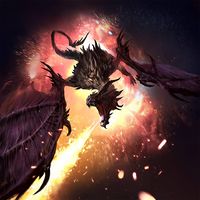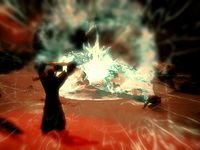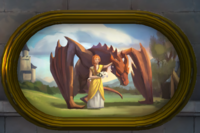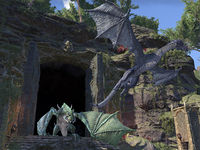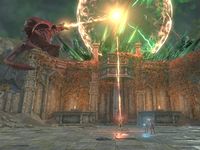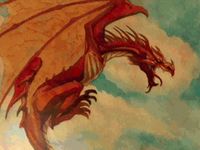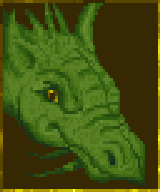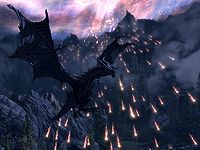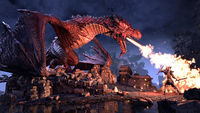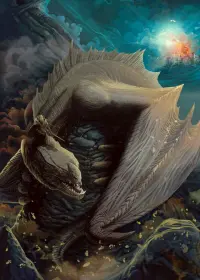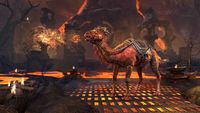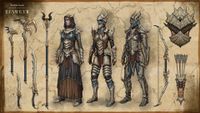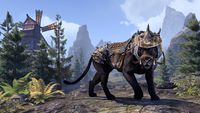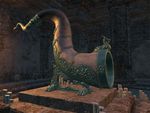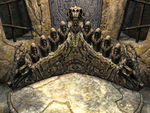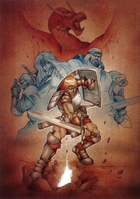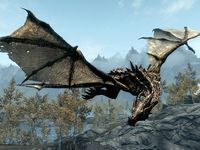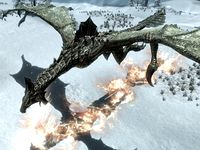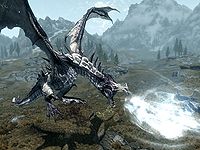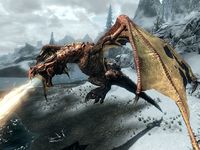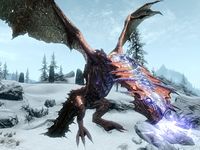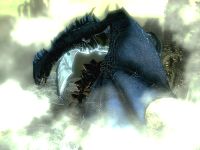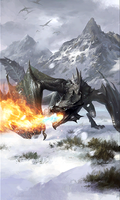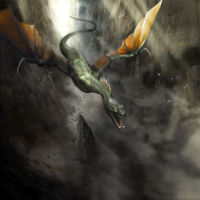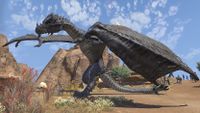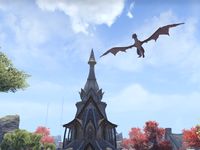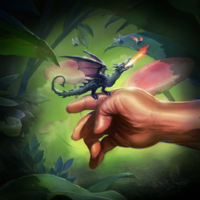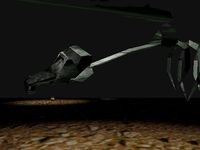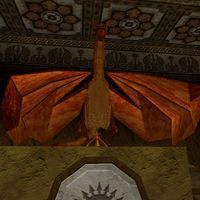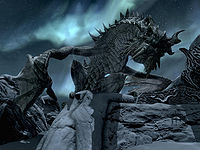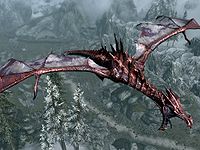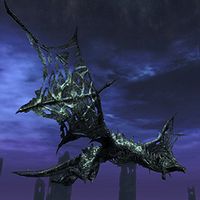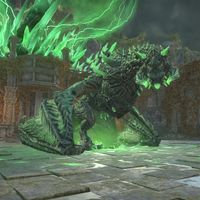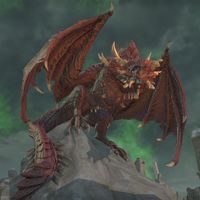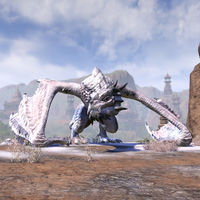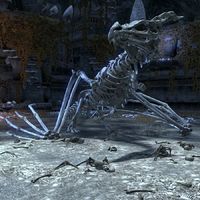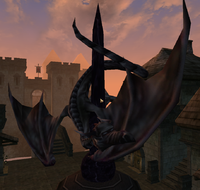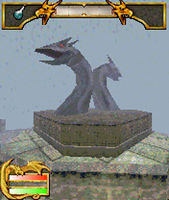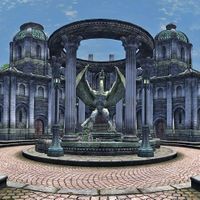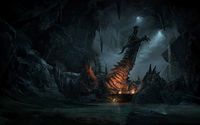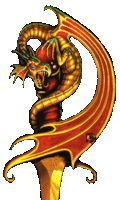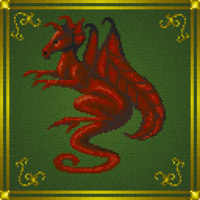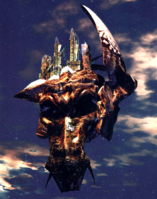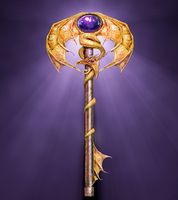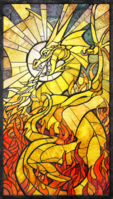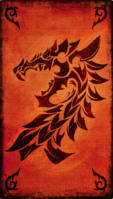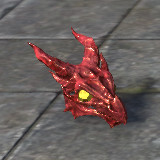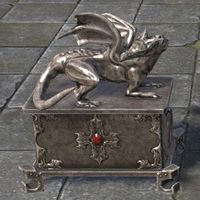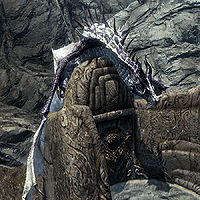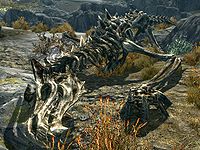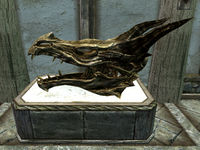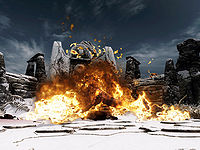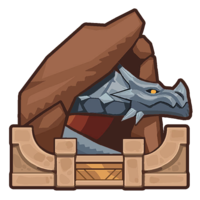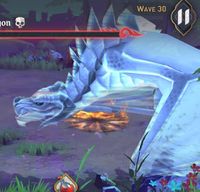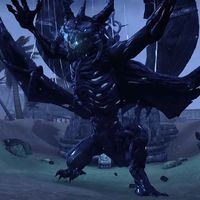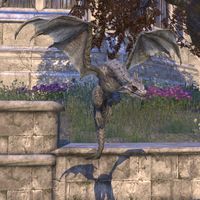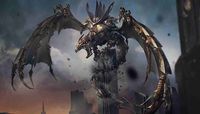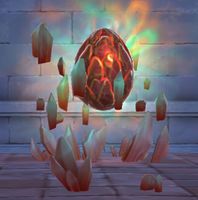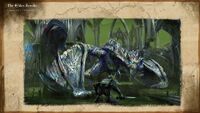Lore:Dragon
| Dragons | |||
|---|---|---|---|
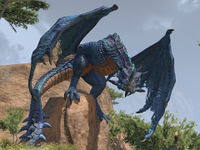 Mulaamnir, a Dragon (ESO) Mulaamnir, a Dragon (ESO)
|
|||
| Type | Race (God) | ||
| Range | Akavir (historically), Atmora (historically), Tamriel | ||
| Appears in |
Daggerfall, Redguard, Skyrim, ESO, Legends, SkyrimVSE, Blades, Call To Arms, SkyrimTAG, Castles |
||
Dragons (also known as drakes, wyrms or worms, dov or dovah in their native language, drah-gkon or dov-rha to the ancient Nords, or Aka in Ehlnofex)[1][2][3][4] are a rarely-seen race of large reptilian beasts of Aedric nature.[5][6] They are rumored to be from Akavir (which literally means "Dragon Land"),[7] though there are ancient tales of Dragons also coming from Atmora.[5][6][3] They are large, scaled creatures, easily several times larger than a human or elf. They have long, slender extremities, with thin bat-like wings and ridges of spikes along their back. Dragons have three sharp talons and one vestigial digit known as a dewclaw on each of their feet, as evidenced by the way their alphabet is written.[8][UOL 1] They are regularly said to breathe fire, but more accurately, they speak it. They speak words in their language a certain way, known as a Thu'um or "Shout", to cause many effects, including elemental breaths such as fire or frost.[9]
Dragons are well-known for their affinity for magic.[6] It is unknown how they possess the ability to speak and fly despite their lack of lips or the fact that their wings are not naturally strong enough to support such heavy torsos.[10][11] There are several varieties of Dragon that come in a range of colors.[3] As the immortal children of Akatosh, they are specially attuned to the flow of time, and they feel an innate urge to dominate others that is near-impossible to overcome.[12] Some sources suggest both dragons and Dragonborn are fragments of Akatosh's soul.[13]
Although Dragons are immortal,[6] their physical form can be destroyed. Although they may appear to have been killed, Dragons defeated in such a manner are not truly dead and can rise again.[14] This is due to the unique properties of Dragon souls, which generally persist eternally due to the link between a Dragon's soul and its physical remains being far stronger than that of a mortal.[15] The main exception to this is if the soul is consumed by a fellow Dragon.[16] This grants the recipient a portion of the knowledge and life essence of their fallen opponent, but it also destroys the Dragon permanently, rendering it beyond the ability of any ritual to resurrect.[17][12] This ability also extends to the Dragonborn, mortals born with the soul of a Dragon, who can become the greatest Dragonslayers by absorbing the souls of their quarry and thereby stealing their power.[18][19] It is also possible to use powerful soul magic to sever the connection between a Dragon's soul and its physical remains, although the effects of this is the subject of fierce scholarly debate, with some speculating that a Dragon soul once severed may simply dissolve over time or return to join Father Akatosh.[15]
History[edit]
Dawn Era[edit]
Mythic Origins[edit]
Akatosh is said to be the father of Dragons, whom he made in his image.[5][20] His avatar often takes the form of golden or flaming Dragon.[21][22] According to Archmage Shalidor, Dragons are in some manner kindred of the Time God, either his children, or lesser relations, or part of him that split off when time began.[23]
Dragons are said to be eternal, immortal, unchanging, and unyielding.[6] According to the writings of Archmage Shalidor, Dragons had existed since before the advent of sequential time in the Dawn Era,[24][25] but were initially as wild as anything else. It was Alduin, Firstborn of Akatosh, who created their civilization.[23] Nordic legend says that, in these early years, the Dragons were the only creatures who could harness the power of their voice for great feats of magic, though they only did so in times of "True Need".[26] Despite Dragons supposedly existing before time was a concept, some Dragons are described as being more ancient than others, with Alduin and Paarthurnax considered the oldest by other Dragons,[27] hence why not all of them are considered equal in power.[28][29]
Some cultures are known to have their own myths concerning the origin of dragons, though it ultimately remains a matter shrouded in ambiguity.
According to a Khajiiti myth, Akha embarked on a journey across the world, following his father Ahnurr's advice to seek love. He mated with beings from distant lands, including the Winged Serpent of the East, the Dune Queen of the West, and the Mother Mammoth of the North, resulting in numerous draconic offspring. After Akha disappeared in the South, Alkosh emerged in his place and took over the role and crown of the First Cat, assuming rule over Akha's children and the myriad kingdoms of Akha along the Many Paths. However, he was eventually overthrown, and his body was scattered on the West Wind. Khenarthi intervened to restore Alkosh, flying across the Many Paths and putting him back together, and the two now watch over the Many Paths and safeguard them from the wayward children of Akha.[30][nb 1]
According to the transcribed creation myth of the Adzi-Kostleel Argonian tribe, Atak the Great Root and Kota the Serpent fought each other for so long that they eventually forgot their fight and became one, forming the entity Atakota. Atakota severed its roots and shed its skin and said the word "Maybe", giving rise to its Shadow, formed of its hunger and shed skin. Atakota continued to roil in a cycle, devouring itself and shedding its skin to be reborn and begin anew, each scale a world that it devoured. From this process the world and spirits arose, with Atak and Kota not in conflict, things now had time to begin and end, and the Shadow too fell asleep. As Atakota slumbered, the spirits started making new things that shared in their aspect and loved them, and they started growing, until they too were as large as Atakota, and forgot it had come before them and had a sleeping Shadow. Soon the worlds and spirits became too big and there was no more room for new things, in desperation, the spirits fell upon the sleeping Atakota and bit into it to drink its blood. Eventually the peace of Atakota broke, Atak remembered growing and Kota remembered being nothing, and existence fell into chaos again. In that time of chaos some spirits drank deeply of Atakota's blood and sap, and they grew scales and fangs and wings, forgetting why they'd ever made anything other than to eat it. Kota's blood made new oceans and Atak's sap made new stones. Eventually the roots woke the shadow and asked for its help, and its intervention put an end to the chaos that was threatening to consume everything.[31]
Whatever the case, Dragons have been known to refer to the Time God as their "father", and have used both the name "Akatosh" and the name "Alkosh" to name their progenitor.[32][12][33][34]
Merethic Era[edit]
Alduin's Reign[edit]
Alduin's leadership over the other Dragons would eventually extend to mankind in the Merethic Era. This Dragon Cult originated in Atmora but would eventually come south to Tamriel where the humans were lorded over with a much crueler hand.[5] beyond the more understood to history rule over Tamriel and Atmora, the Dragons at the height of their power were said to rule the whole world.[26][35] Though all dragons swore fealty to Alduin,[9] his younger brother, Paarthurnax served as his chief lieutenant and right hand.[36] Others, like Kaalgrontiid traveled further south, seeking to establish their own kingdoms outside of Alduin's direct supervision.[37] Under the dragons were certain humans who held a special connection with the dragons known as the Dragon Priests.[5] At the bottom of the rung lied the mortal servants who lived under the heel of these cruel masters.[5] The center of power in Skyrim of this Dragon empire is thought to have been Bromjunaar, where Dragon priests decided matters of their law.[38]
Nordic legend holds that Alduin led his brethren and their once-benevolent minions to terrorize and subjugate the mortal races, triggering a rebellion.[5][10] The Dragons began indiscriminately slaughtering them under the orders of Alduin, who had chosen to forsake his proper duties and conquer the land.[12][39]
During this Dragon War, mortals found ways to kill the Dragons, who were previously thought undefeatable.[5][6] Some people, notably priests of the Nine Divines, claim that Akatosh intervened against the Dragons to help end the war, and that some Dragons fought against their own kind.[5][40] Paarthurnax took pity on the Nords (purportedly at the request of Kyne), and instructed several in the ways of the thu'um so that they could channel the power of their own voices using the tongue of the Dragons.[12] These first Tongues (masters of the Voice) used their new power to turn the tide of the war, and they eventually "shout[ed] Alduin out of the world".[5] The remaining Dragons were hunted and killed until they were nearly extinct, clearing the way for the many empires which have risen and fallen since.[5][40]
Khunzar-ri and the Demons[edit]

In the Merethic Era,[41] when Elsweyr was composed of sixteen kingdoms, Kaalgrontiid and his rage of Dragons came to dominate the land, seeking to consume the Moons' lunar power. To stop them, the Khajiit hero Khunzar-ri recruited four companions, Nurarion the Perfect, Flinthild Demon-Hunter, Anequina Sharp-Tongue, and Sir Cadwell.[42] When fighting them proved to be futile, Cadwell suggested that it may be best to convince the Dragons that they were willing to aid them in their plans. In preparation, Anequina attuned to Shadow Dance Temple, making the moons align to form an eclipse, allowing the Moon Gate of Anequina to open a portal the Plane of Jode, where the object the Dragons desired, Jode's Core, rested. The Dragon's ambitions would be their undoing; when the Dragons accessed the Plane of Jode, Khunzar-ri convinced them to not simply absorb the power of the core like they originally intended, but instead store their energy within it in the guise that they would combine the lunar power with their own.[43][44] The gamble worked, and the Dragons were weakened enough for them to retreat back into the wilderness.[42] To finish the job, Khunzar-ri once again convinced the Dragons to play a part of his scheme. He managed to lure them into the Halls of Colossus, where he managed to seal them away. In the aftermath, Khunzar-ri wrote on the legendary Wrathstone in an ancient Ta'agra dialect, writings detailing the cartography of the location of the Demon Weapon. The Wrathstone itself is however much older than the Ta'agra writings.[45] The Dragons would be obscured as "demons" in legends, and become the fabled "Demon Weapon". Their power would be coveted by many people.[42]
First Era[edit]
Declining Influence[edit]
After the time of the Dragon Cult passed and their kind was no longer welcome in Tamriel, Dragons are thought to had begun to prefer remaining within solitary mountain lairs safe from thieves and aggressors.[1] Some Dragons even took up roost in occupied caverns, kicking out the local inhabitants in the process.[46] According to some claims, Dragons were unable to settle in Morrowind due to being preyed upon by skylamps,[47] or overwhelmed by cliff racers.[UOL 2]
In contrast, the fictionalized account of King Edward describes Dragons of the early First Era as openly living in and around isolated mountain villages. The villages were purportedly situated in areas that allowed flight free of obstructions as well as flats for raising cattle.[48] A painting of a maiden with a tame red Dragon was known to have been created during the 16th century of the First Era.[49] One obscure account mentions several Dragons being involved in the All Flags Navy's invasion of Thras.[UOL 3]
Hunters from the East[edit]
The Tsaesci of Akavir were known to hunt Dragons throughout their history. At some point in the First Era or earlier, they sought to "eat" all of the Dragons. The Black Dragons managed to escape them into Po Tun but they successfully enslaved the Red Dragons, and went on to use them as war mounts.[3][50][51] However, after a war with the tiger people, the Dragons of Akavir were almost entirely wiped out.[3] At some point after this, the tiger people tried to become the Dragons. It is rumored that Tosh Raka, their leader, was the first to succeeded. He is said to now be the largest Dragon in the world.[3]
The Tscaesi continued their crusade against the Dragons in Tamriel.[52] After their invasion of Tamriel and surrendering to Reman in the late First Era, the Akaviri Dragonguard was formed, dedicated to hunting Dragons.[19] Additionally, Akaviri Dragon motifs and the practice of creating armor from Dragonscale would become common in Imperial culture. Their war mounts, the Red Dragons, would also come to symbolize the Empire itself.[50] Reman eventually stopped making sport of their kind, though certain hunters many years after his time sought out dragons to slay them, such as the group that found Thurvokun.[53]
The Demon from the East[edit]
Sometime in First Era after the formation of the Dragonguard, the Dragon threat re-emerged in Elsweyr. The hero Jadarri formed an alliance with Reman's Dragonguard and the red Dragon Nahfahlaar. She was tasked by Alkosh to use the Mask of Alkosh to extinguish a creature that threatened to unravel all of time: Laatvulon, a Black Dragon known as the Demon from the East.[54] Ja'darri petitioned Nahfahlaar to imbue the Mask of Alkosh with his power to help defeat his ancient foe Laatvulon.[55] In an act he would later regret, he refused, leaving the Dragonguard to fight Laatvulon with limited power.[55] They would ultimately succeed in imprisoning Laatvulon but it cost Ja'darri her life.[56][55] Upon death, she was said to join Alkosh in a realm beyond even the Sands Behind the Stars.
Ja'darri's tomb has ancient tablets telling of four Khajiiti spirits stepping in to aid Elsweyr. It claims that Azurah saw the coming of Laatvulon, and responded by opening the Crimson Gate so that her children could make their stand. It additionally mentions Alkosh's interest in ridding Elsweyr of the Dragons, and that Lorkhaj returned and fought the darkness back and slayed many Dragons.[57]
Second Era[edit]
The Hunt Continues[edit]
While the Dragonguard was officially disbanded at the turn of the Eras.[58] Many continued hunting wary surviving dragons in Skyrim until at least 2E 373.[40] Grahkrindrog was slain by the Dragonguard in 2E 184, after perpetrating great slaughter in Winterhold and Eastmarch in northeast Skyrim. The Dragon's name was supposedly confirmed to the Dragonguard with assistance from mages of the College of Winterhold. His death was later documented by the Dragonguard in 2E 373.[40]
A splinter group known as the Dragonknights would also continue the Akaviri traditions, though the abilities of this group allegedly came from the Dragons themselves.[58][59][60]
A Rage of Dragons[edit]
After the retrieval of the Wrathstone around 2E 582, the Imperial battlemage Abnur Tharn inadvertently unleashed the Dragons from their containment from the Halls of Colossus, thus causing them to continue in their quest for the Moon's Lunar Power. The Dragons allied themselves with the forces of the Queen of Rimmen, Euraxia Tharn, who were led to believe that the Dragons were willing to be used as tools. The Dragons were quick to cross Euraxia when she was no longer of use to them, and they were left without their aid against the forces of Elsweyr Defense Force as well as the Vestige. The turn of events resulted in her death and the return of Rimmen to Khajiit control. Euraxia's forces now without a leader, allied with the Dragons to avoid their wrath. The Dragons plans were put to a halt when the Vestige stepped into the Plane of Jode and defeated Kaalgrontiid and his kin, preventing the lunar power from being completely absorbed.
Dragon sightings became more frequent, with many coming out of hiding after learning of Kaalgrontiid's return.[61] The Dragons Nahviintaas, Yolnahkriin, Lokkestiiz took residence within Sunspire, claiming to be the gods Alkosh, Jone, and Jode, and converted the majority of the shrine's devotees to their cause. In an attempt to correct the mortal mistake, Nahviintaas plotted to rip the time wound left behind from the battle between Alkosh and Pelinal long ago. The Undaunted learned of this, and fought through the hordes of cultists, and killed each of the false gods.[62] The Dragon Maarselok nested near the mountains within the Tenmar Valley, near the Valenwood and Elsweyr border. There, he emitted the dreadful Azureblight from his body, a dangerous blight intended to create an "azure world", where all life would be twisted to his will. Without the aid of the Undaunted and the changeling Selene, the corruption would have spread to the Elden Tree.[63]
The Dragon Laatvulon sought to continue his master Kaalgrontiid's plan of bringing on the Dark Aeon, intending for Kaalgrontiid to become Akatosh's equal. To this end, Laatvulon created a Khajiiti Dragon cult, the New Moon Cult, whose ranks were bolstered by many of the vulnerable Khajiit from the region, such as those who were affected by the Knahaten Flu.
The red Dragon Nahfahlaar, who was Laatvulon's ancient rival, dueled Laatvulon near the city of Senchal in southern Elsweyr, but was overpowered due to Laatvulon's newfound power. Afterwards, taking refuge in Tideholm, Nahfahlaar was encountered by the Dragonguard, which had been recently reformed by the Redguard Blademaster Sai Sahan. Seeing that Nahfahlaar meant no harm, an alliance was forged once again with former foes/allies, one in which Nahfahlaar served as a valuable asset. This alliance led to victory, and Laatvulon, the Demon from the East, was slain.[55]
Nahfahlaar subsequently aided the Dragonguard in defeating Kaalgrontiid and the remnants of the New Moon Cult. Kaalgrontiid returned and planned to siphon the energy he collected from Jode's Core and become empowered by a giant cluster of Aeonstone. To prevent anyone from disrupting his plans, he utilized the energy of the Aeonstone to create an aegis, a massive and impenetrable ward, around the ancient fortress of Dragonhold. Through the combined efforts of Nahfahlaar, the Dragonguard, and Queen Khamira's forces, Kaalgrontiid was slain. However, the Dark Aeon became unstable as a result of Kaalgrontiid's machinations and threatened to destroy the entire continent of Tamriel. It required the combined power of Abnur Tharn and Nahfahlaar to prevent the Aeonstone from affecting the area outside of Dragonhold. Nahfahlaar and Abnur were successful, but only at the cost of Abnur's life. After putting a stop to the rage of Dragons, Nahfahlaar sought out another place to wait until his intervention became necessary once again.[55]
The "Disappearance" of the Dragons[edit]
Dragons had continually become more elusive after losing their grip on power back in the Merethic Era.[64] Their numbers dwindled over the years due to many causes: much of their population in Akavir was wiped out or enslaved by the Tsaesci, who also brought their onslaught to Tamriel.[3] The Akaviri Dragonguard and its successor, the Blades, along with other heroes, hunted Dragons and their followers throughout the eras until Dragons were nearly extinct.[1][40][19]
After his rule was established in 2E 854,[65] Emperor Tiber Septim offered many of the remaining surviving Dragons protection and spoils in return for their fealty.[6][UOL 2] Among the Dragons who served him was Nahfahlaar, now known as Nafaalilargus. Circa 2E 864, during the reign of Tiber's Empire, Dragons were said to circle overhead of the Imperial City, with River Dragons rusting their hides in its surrounding waters.[50]
Despite Tiber's pledge, almost all known wild Dragons were killed or driven off, disappearing from sight in Tamriel.[40][6] Some sources claim that all Dragons disappeared at once, being devoured by a Dragon king or absorbed by Tiber Septim when he ascended to godhood.[6] Many held the belief that the Dragons were extinct.[28] This was not true, as many live Dragons continued to exist in obscurity throughout the Third and early Fourth Era.
Third Era[edit]
There Be Dragons[edit]
It is believed that, at sometime between 3E 111 and 3E 153, Sir Amiel Lannus and the Knights of the Nine traveled to the ruins of Elenglynn and smote a Wyrm to recover the Cuirass of the Crusader.[66] Nomads in the Alik'r Desert frequently spoke of "Great Wyrms" inhabiting its vast wastes, although these claims were never independently confirmed.[67] Various "Dragon's Dens" were known to exist throughout the Iliac Bay region in the Third Era, littered with charred remains, though it is unclear if Dragons actually took residence within these.[68]
Many tales tell of Dragons making deals with other races to protect themselves.[40][69] Among known examples, some remained in service to the Empire. One Dragon served as the companion of an Imperial Battlemage,[70] and it is said the Imperial Guard as a whole had an elite unit of Dragon riders.[UOL 2] The Akatosh Chantry held Dragons as their holy symbol, and kept live Dragons (or possibly just dragonlings) in their "sacred groves".[71][39] Skakmat is a Dragon who served as the familiar of the Dowager Queen Nulfaga.[72] Quite notably, Paarthurnax was able to remain in seclusion atop the Throat of the World, guarded by the Greybeards of High Hrothgar.[12][16]
Fourth Era[edit]
Prelude to Return[edit]
Accounts of surviving Dragons continue into the early Fourth Era. Several Dragons were encountered by the Warrior circa 4E 180.[73] Among these was one named Shulkunaak who assisted the Warrior with information that was essential to defeating the Ayleid lich Celemaril the Undying.[74]
The World-Eater Wakes[edit]
In 4E 201, Alduin reappeared at the Throat of the World, cast forth from the Time-Wound created when he had been banished thousands of years before. Perched here was his brother, Paarthurnax, who awaited his return at the summit of the Throat of the World ever since his banishment.[12] However, Paarthurnax was unable to contain Alduin, and the World-Eater descended upon the region. In the midst of all of this, several members of the Stormcloak rebellion were being executed by Imperial Legionnaires in Helgen, including the rebel leader Ulfric Stormcloak.[75] Accidentally caught up in this string of executions was a prisoner who was detained for crossing the border.[75]
Before this prisoner or Ulfric Stormcloak could be executed, Alduin descended upon Helgen and quickly reduced the settlement to rubble. Several parties were able to narrowly escape the destruction including Ulfric and the prisoner.[75] Ulfric Stormcloak's resulting escape prolonged the civil war in Skyrim and secured a steady flow of souls for Alduin to consume in Sovngarde.[76] Alduin began to resurrect his fallen brethren, using a powerful thu'um (seemingly known only to him) to undo their deaths and restore flesh to their bones.[77] Dragon Priests and draugr began to stir in ancient ruins as well, setting the revitalization of Alduin's army and the Dragon Cult in motion. The mysterious prisoner was eventually revealed to be the Last Dragonborn, the hero of an ancient prophecy.[78]
As a Dragonborn, the hero was able to wield the thu'um with preternatural ease, learning several powerful shouts that allowed them to slay Alduin's dragon allies and absorb their souls, increasing the hero's strength and ensuring Alduin could not revive them again. With the aid of an Elder Scroll, the Last Dragonborn learned the forgotten thu'um known as Dragonrend that served as a great weapon against Dragon kind, forcing understanding of mortality into their immortal minds.[79] With this new magic, Paarthurnax and the hero confronted Alduin on the Throat of the World, where the two sides fought to a stalemate. Given his unique nature, it was seemingly impossible to slay Alduin on Mundus.[79]
Eventually, the Dragonborn gained access to Sovngarde, where Alduin had fled to regain strength.[80] Shor gave council for the heroes of Sovngarde to stand down, allowing the Last Dragonborn to face Alduin as foretold with the help of the three ancient Nord heroes who banished Alduin in the first place.[81] With that, the quartet finally vanquished the World-Eater.[80] Alduin's soul was not absorbed by the Dragonborn, and he may not have been completely destroyed:[80] it is possible that he will one day return to fulfill his role as the World-Eater.[16]
The surviving dragons had varying reactions to Alduin's vanquishing. Paarthurnax lamented the death of his brother but intended to teach the surviving dragons the philosophy he had come to adopt, the Way of the Voice.[12] Some dragons viewed this attempt at new leadership by Paarthurnax as tyranny, instead bowing to the superiority of the Last Dragonborn, who, as the slayer of Alduin, they felt was the rightful heir to his lordship.[27] Even realms beyond the Mundus felt ripples from the World-Eater's destruction. A dragon in the Soul Cairn by the name of Durnehviir learned of the event and proclaimed the Last Dragonborn a true Dovah for the deed.[82]
The remaining Dragons would continue to be found throughout Skyrim and Morrowind,[83] though their ultimate fates are unknown.
Behavior and Culture[edit]
Blessed with remarkable intelligence, Dragons are nonetheless susceptible to feelings of pride and melancholy. Dragons possess an innate urge to dominate others that is near-impossible to overcome. As such, they are distrustful creatures, even of each other. Despite this, they are also somewhat social, and can be driven mad by captivity and isolation.[12] In the mind of a Dragon, being powerful and being right are the same, thus they make no distinction between speaking and fighting; battles between them are actually deadly verbal debates.[28][16] Dragons are known for their custom of sosmir, the blood allegiance, a mystically binding pact and an unbreakable bond, stronger than any vow uttered by a mortal, which causes the dragon bound by it to pay their debt by the ancient magic.[55]
Though they value strength and feel an urge to dominate those around them, Draconic culture also values caution and cunning, and a number of their sayings emphasize that one should focus on such things over might and directness depending on the situation. These sayings urge Dragons to be well aware of their strengths and weaknesses so as not to fall prey to them, to be wary of being betrayed but inversely not hesitate to betray should it benefit them, to not narrowly focus on their own goals but remain aware of surrounding circumstances, to always secure their resources before acting, and to always look deeper into the true cause of things and not content themselves with a surface explanation. Despite this culture of caution, dragons are also urged to persevere and seek glory when faced with challenges, soar higher to the sky rather than returning to the safety of the ground.[84]
Dragons are known to hunt for food, while they are primarily carnivorous, some have been observed grazing on vegetation. Dragons seem to have a preference for hunting intelligent prey, as they enjoy the extra challenge it provides.[85] Dragons are known to prefer inhabiting mountains.[12] Some stories tell of a Dragon named Akatosh co-mingling with and organizing groups of Dragons in isolated mountain villages, although this representation may be entirely fictional.[48] There is some indication that Dragons are capable of practicing smithing.[86]
Dragons are known to collect hoards of treasure.[87][88]
Characteristics[edit]
As beings known of their high magical affinity, Dragons are sensitive to and can sense arcane phenomena. They are known to be able to sense the accumulation of magic even across large distances, and can even sense specific characteristics about the source of the magic itself. Traits such as the power belonging to another Dragon and that Dragon's disposition, the age of the one the magic comes from, and even whether they are suffering from some illness, are all things a Dragon's senses can perceive.[6][55] As children of Akatosh, Dragons are especially attuned to the flow of time, and possess the ability to sense events which disrupt or break its flow.[12]
Dragons possess the ability to devour things beyond the physical, and have been known to eat things such as souls, lifeforce, and even the lunar energies of Jode's Core in order to increase their power. This arcane feeding process can sometimes cause the Dragon's size to increase and its very form to change.[33][55][27][89][90] The lifeforce of Dragons themselves can also be channeled into other things, whether willingly or unwillingly, though only specific things which have it in their nature to fully devour Dragons can absorb it fully.[42][43][44]
A Dragon's presence can have an effect on the conditions of the surrounding area. The long imprisonment of the Dragon Laatvulon within Doomstone Keep caused the fort to become infused with his "icy malice", making frost cover large sections of the structure and the corpses within rise as ice imbued undead, even after his stay there ended. At Sunspire, the Dragon Yolnahkriin resided in the caldera, where his presence is said to have "stoked the sleeping mountain's fire".[55][91][92]
A text by a Khajiit Moon-Priest, transcribed by a scholar of the Mages Guild suggests that Dragons, Clan Mothers of the Pride of Alkosh, and Pridehome exist in some sense outside the tapestry of time and of linear progression, and so have always existed and will always exist, irrespective of what has occurred from the perspective of those bound by linear time. Consequently, the "Doom to Come" the time when Dragons return to bring imbalance to the world, will also always exist. The text mentions this now also applies to Abnur Tharn due to the circumstances surrounding his disappearance.[93]
Variants and Mimicry[edit]
Dragons individual appearances can vary wildly, possessing variations in head-shapes, horns, spikes, tails, and other attributes.[94] A Dragon's color is often indicative of how powerful it is.[28] Brown-skinned Dragons and green-skinned "Blood Dragons" are generally weaker than the white-skinned "Frost Dragons" or bronze-skinned "Elder Dragons" and "Ancient Dragons".[28][95] Two particularly distinct types of Dragon, are Red Dragons, some of which are "Fire Dragons", and Black Dragons, some of which are "Storm Dragons".[3][85][94] Originally from Akavir,[3][50] these Dragons do not seem to take part in the hierarchies of other Dragons.[85] Many Red Dragons throughout history have served with or under mortals.[50][27][55][49]
Serpentine Dragons found on Solstheim, are named for their distinct, snake-like heads. Revered Dragons have strange flat heads and some are known to have semi-aquatic behavior. The incredibly powerful Legendary Dragons are known to possess strange compound eyes.[95] River Dragons were said to reside in Cyrodiil during Tiber's reign, they are known to rust their hides in bodies of water.[50]
Jills are mythical beings, said to fix the world during Dragon Breaks.[96][nb 2] Some sources describe them as female Dragons.[UOL 4][UOL 5] Female Dragons are also mentioned in the historical-fiction, King Edward.[48]
Undead[edit]
Living Dragons can rarely become undead, as in the case of Durnehviir, a Dragon necromancer who became trapped in the Soul Cairn for so many centuries that his soul became bound to that plane, dooming him to an eternity of undeath.[82] Even without a Dragon soul, the mortal remains of a Dragon can prove to be a dangerous opponent. Bone Dragons are highly prized by necromancers for use as undead minions.[97] Although there have been no sightings of vampiric Dragons, illusion imps have been known to take on the form of small vampiric Dragons to scare away potential foes.[98]
Associated Creatures[edit]
Wyrms are ethereal, elemental beings with Draconic appearances that are often summoned by Dragons.[99] Dragons themselves are often referred to as wyrms. Wyverns are fire-breathing creatures of doubtful existence.[100] The spell "Wyvern's Sting" is named after them.[101] According to a fib from Alchemy, a member of the House of Reveries, those born to a Dragon and a mortal can turn into a wyvern during a full moon.[100] Due to the joking nature of her statement, this description of wyverns is highly unlikely. Lizardmen have similarly been described as "a hybrid of a man and a dragon".[UOL 6]
So-called "Dragonlings" (also called "Fairy Dragons")[102][UOL 7] found around the Iliac Bay area are sometimes believed to be young dragons,[103][104] however Fourth Era scholars claim they are merely oversized lizards, with no relation to true dragons.[6] They however seem quite intelligent in their own right. They are capable of casting spells, speak Dragonish, and are said to be very wise.[67] Tiny Dragons have been seen in the Shivering Isles, but given the nature of the Isles it is unclear if these are real Dragons.[105]
Dragon Frogs are fire-breathing winged frogs who stories in Hammerfell claim to have once been actual Dragons before being transformed.[106] Wamasu are large reptiles native to Black Marsh that have been mistaken for Dragons,[86] being colloquially known as "Swamp Dragons".[107] Their eggs are sometimes mistaken for supposed Dragon eggs,[15] the same being true for sep adder eggs.[108] Sea-Drakes are large aquatic reptiles also seemingly named for Dragons.[109]
Draconic Imitations[edit]
The Dragon, one of the Luminaries of Magic, immortal beings of pure magic capable of choosing their own shapes, took the form of a female dragon, having chosen the shape for its majesty.[110][111] Peryite also takes the form of a Dragon, but this may only be as some primordial jest to Akatosh.[UOL 8] Daedric Titans are a form of Daedra that were first created by Molag Bal in imitation of the Dragons. The first Daedric Titan was created using the skeleton of a real Dragon; Boziikkodstrun, as its basis.[112]
In 2E 582, the significance of a number of Dragons that followed Kaalgrontiid allowed them to be documented within the Infinite Archive in Apocrypha. There, copies of various entities were subsequently created as maligraphies, creatures composed of vivified ink manifested by stories from books, serving as mindless extensions of the Daedric Lord Tho'at Replicanum. Maligraphic copies of the Dragons Mulaamnir, Laatvulon, and Yolnahkriin were formed, and were confronted by an adventurer or two who were aided by augmentations directly from Hermaeus Mora. In addition, Tho'at Replicanum replicated herself throughout the Archive, with the form of a Glass Dragon being one of the shapes her copies took.[113][114][115] During that same year, a number of Daedra in the form of Glass Dragons were observed flying around the prison of the Daedric Prince Ithelia, the Prince who Tho'at Replicanum is associated with.[UOL 9][116]
Some illusion imps use magic to disguise themselves as small Dragons, as a way to trick others into taking care of them. These disguised imps are sometimes known as "Dragon imps" and are often mistaken for baby Dragons.[117] Followers of Akatosh sometimes create illusions of small, fiery Dragons to follow them.[118] Necromancers have been able to create skeletal constructs out of bird and reptile bones that resemble miniature Bone Dragons.[119][120] The Telvanni magister Varknel was once commissioned to create a Dragon. To approximate one, he used a mix of Telvanni and Wood Elf techniques to create a fire-breathing camel-lizard with red scales.[121]
Tonal Dragons are ethereal beings resembling ghostly Dragons. They are created through tonal architecture.[122] Clockwork Dragons are constructs created by Sotha Sil,[123] though their exact origins are unknown.[UOL 10] They should not be confused with Clockwork Titans,[124] as apart from some shared design elements found in Sotha Sil's creations, there is no other known connection between them.[UOL 10]
Uses[edit]
Dragonscale and Dragonbone have seen use in the creation of arms and armor since the Merethic Era.[125] There is considerable evidence that orthodox Dragon Priests had their armor crafted from genuine remains of the great creatures.[126] Some Dragons have awarded pieces of themselves willingly as part of an alliance or bargain. The Dragon Numinex provided Draconic armor in exchange for his life.[127]
The practice of creating armor from Dragonscale was a common practice in Akaviri culture, and would become common in Imperial culture following their invasion in the First Era.[50] Members of the Dragonguard were also known fashion armor from the bones of the Dragons they slew.[128] Imperial Dragonscale armor would still see use into the Third Era, after the majority of Dragons had died off or gone into hiding,[129] and the Imperial Legion was known to be in possession of stockpiles of Dragonbone well into the Fourth Era.[128] Dragoneye helmets were known to exist in the late Third Era.[130]
Dragonscale and Dragonbone were known to have become very rare materials as early as the Second Era,[126] with them remaining that way into the early Fourth Era.[131] Despite their rarity, they still saw occasional use in mundane life during this time. Various trinkets in the Second Era were known to be crafted out of the materials.[132][133] Certain amulets of Talos are crafted with Dragonbone and scales.[134] The materials became easier to obtain after the return of the Dragons circa 4E 201.[135]
Dragon's scales,[136] as well as their claws,[137] blood, and bile, all have alchemical applications.[138] Imbibing a Dragon's blood can grant the drinker increased power, and strengthen their talent in the use of the Thu'um, but it is a brief benefit, as the blood also causes the body to start burning from the inside, dooming the drinker to a slow death.[139][140][141] Dragons are known to be vulnerable to weapons tipped with their own Dragonfire,[88] and Dragon Knights were known to ride upon large flaming wolves, which some speculated had been imbued with Dragonfire.[142]
Roasted Dragon meat is said to be dense and thick with ligaments, and to have a taste similar to fowl.[143]
Artifacts[edit]
There are a number of artifacts that are associated with Dragons, whether created by them or out of them.
Dragonhorns[edit]
Dragonhorns are legendary artifacts crafted primarily by the Dragonguard, used as weapons against the Dragons. They are magical warhorns carved out of the horns of dragons, inscribed with various arcane runes, and are capable of producing a tonal sound that incapacitates dragons. They however will have no effect if used against the dragon the horn originated from. Widely manufactured in the late First Era by the Dragonguard, dragonhorns were gifted to key locations for their protection and are rare to find. They are considerably fragile, and can break instantaneously and crumble to dust after just a few uses. Lunar energy can be diverted into dragonhorns to charge them up with the arcane power capable of hindering dragons. The portable mouthpiece portion of a dragonhorn is called a Combat Dragonhorn.
Dragon Priest Masks[edit]
The masks of the Dragon Priests are strange artifacts created by the dragons in the Merethic Era. The highest ranking priests of the Dragon Cult were granted magical masks that defy the laws of time and possess powerful, mysterious enchantments. The individual masks are made of varying materials, and each bears the same name as the Dragon Priest that possessed it. The names are in the dragon language, and can be translated. The number of masks in existence is unknown, and some are apparently older than others. The masks were buried with their owners, until in 4E 201 the return of the dragons caused many of the undead Dragon Priests to awake from their slumber.
Dragonbone Mail[edit]
The Dragonbone Mail, or the Dragonbone Cuirass, is thought to be one of the greatest artifacts any collector or hero could own. While many fine pieces of armor have been constructed with real dragon bone, the Dragonbone Mail was enchanted by the first Imperial Battlemage of Tiber Septim, Zurin Arctus, in the early years of the Third Era. It's described as a truly exquisite piece of work, and many have sought to possess it.
The properties of the cuirass allow the wearer to resist fire, and to damage an enemy with a blast of fire. Little is known about the involvement of Zurin Arctus with the enchantment of the cuirass, but an old tale speaks of a debt that he owed to a traveling warrior. Like the warrior, the Dragonbone Mail never stays put for long.
Goldbrand[edit]
The Goldbrand is an ancient artifact created by the dragons of the North which takes the form of a golden katana. According to legends, they first bestowed the blade upon the Nordic warrior Sivdur, (ancestor to the modern Battle-Born clan) who was sworn to protect them. It contains the power of the Daedric Prince Boethiah, and burns those that it strikes.
Mask of Alkosh[edit]
The Mask of Alkosh is a holy relic of the Dragon-Cat Alkosh, his light willing it into existence to help mend the tapestry of time, and is worn by the champions of the Pride of Alkosh. It was first worn by the Ja'darri the Endless, the first champion of Alkosh and the founder of the Pride of Alkosh. A Dragon must awaken the dormant power within the mask before it can be used. When the mask is empowered, it imbues its wielder, known as a Mask-Bearer, with extraordinary power.
Ward of Akavir[edit]
The Ward of Akavir is a priceless artifact treasured by the Imperial Legion. It is a tower shield with an Imperial Dragonscale design, made from the actual skin of a dragon. It bears a powerful enchantment which makes the wielder far luckier. Its origins are unknown, but its name implies that the artifact is related to the continent of Akavir in some way.
The shield was originally possessed by the Imperial Legion. It was stored within Fort Firemoth, an Imperial outpost located in the Inner Sea of Morrowind. Some time in the Third Era, an undead skeleton army led by the lich Grurn marched out of the sea and overran the fort, leaving few survivors. To the Legion's shame, the Ward of Akavir was lost. Grurn claimed it for himself and took it deep underground, to a Velothi tomb located below the fort.
Notable Dragons[edit]
- Alduin - First-Born of Akatosh, bringer of the end times
- Baelthon - An undead skeletal Dragon in service to Mannimarco, the God of Worms.[UOL 11]
- Boziikkodstrun - Transformed into the first Daedric Titan by Molag Bal
- Debudjen - A potentially fictional female Dragon mentioned in King Edward.[11]
- Dragonne Papré - Lived in the Battlespire
- Durnehviir - An undead Dragon who guards the Soul Cairn
- Kaalgrontiid - Leader of the rage of Dragons in Elsweyr in 2E 582
- Laatvulon - A black Dragon that was said to threaten to unravel the tapestry of time
- Lokkestiiz -A white dragon who posed as Jone at the temple of Sunspire.
- Maarselok -An azure dragon who unleashed an enthralling disease known as the Azure Blight in the Tenmar Jungle.
- Ma-Tylda - A potentially fictional Queen of Dragon-kind, contemporary of Akatosh.[11]
- Nahfahlaar - Also known as Nafaalilargus. He often allied with mortals and was a soldier of Tiber Septim. He was slain by Cyrus the Redguard
- Nahviintaas - A golden Dragon who posed as Alkosh at the temple of Sunspire
- Numinex - A legendary Dragon imprisoned for many years by King Olaf One-Eye
- Odahviing - A red Dragon who allied himself with the Last Dragonborn
- Paarthurnax - Younger sibling to Alduin, and the one responsible for teaching the Nords how to use the thu'um
- Sahrotnax - A blue Dragon who was longtime enemy of the Dragonguard of Reman III and survived many parleys with the order before finally being fatally wounded by the Nord Grundwulf.
- Shulkunaak - An ancient Dragon who was still alive and living in Cyrodiil circa 4E 180.
- Skakmat - Nulfaga's familiar, who created the dense fog at the Battle of Cryngaine Field[72]
- Thurvokun - Abandoned the Dragon Cult and lived well into the First Era before being slain
- Tosh Raka - King of the Ka Po' Tun who, according to popular myth, was transformed into a Dragon[3]
- The Wyrm of Elenglynn - An infamous Dragon associated with the Ayleid city of Elenglynn. It is believed that, at sometime between 3E 111 and 3E 153, Sir Amiel Lannus and the Knights of the Nine traveled to the ruins and smote this Dragon to recover the Cuirass of the Crusader.[66][144]
- Yolnahkriin -A red dragon who posed as Jode at the temple of Sunspire.
Gallery[edit]
Dragons[edit]
Notable Dragons[edit]
The reanimated skeleton of Thurvokun
(ESO)
Statues and Friezes[edit]
Other Iconography[edit]
Other[edit]
Notes[edit]
- The use of "Dragon" in the nomenclature of northern Hammerfell is very common. From the smallest to the largest scale, there is the village of Dragon Gate,[145] the cities of Dragonstar[146] and Dragontail,[147] the region known as Dragon Fields,[146] and the mountain ranges known as Dragontail[147] and Dragon's Teeth.[148]
- In the Fourth Era, there was some form of dance known as "Baby Drake".[149]
See Also[edit]
- For game-specific information, see the Redguard, Skyrim, Elder Scrolls Online, Legends, Blades, and Castles articles.
- Dragon Language
- Dragon Alphabet
- For a list of notable Dragons, see here.
Books[edit]
- Atlas of Dragons by Brother Mathnan — A glossary of Skyrim's dragons
- Dragons of Southern Elsweyr by Xandria Prevette, Scholar-at-Large — A short recording of observed dragon behavior
- The Dragon War by Torhal Bjorik — A religious text describing the primordial war between men and dragons
- King Edward — The story of the life of a long-ago king
- Meet the Character - Mulaamnir by Centurion Jagus — Extracts from an Imperial's journal detailing his interactions with a group of dragons
- Mysterious Akavir — Information about the continent Akavir
- There Be Dragons by Torhal Bjorik — A report on the nature of dragons
- Varieties of Dragons: An Initial Exploration by Axulsha of Black Marsh — A treatise on different types of dragons
References[edit]
- ^ a b c Olaf and the Dragon — Adonato Leotelli
- ^ The Story of Lyrisius — Bresne Smythe
- ^ a b c d e f g h i j Mysterious Akavir
- ^ Artorius Ponticus Answers Your Questions — Bishop Artorius Ponticus
- ^ a b c d e f g h i j k The Dragon War — Torhal Bjorik
- ^ a b c d e f g h i j k There Be Dragons — Torhal Bjorik
- ^ Pocket Guide to the Empire, 3rd Edition: Other Lands — Imperial Geographical Society, 3E 432
- ^ Word Walls in Skyrim
- ^ a b Arngeir's dialogue in Skyrim
- ^ a b Dragon Language: Myth no More — Hela Thrice-Versed
- ^ a b c King Edward, Part XII — Anonymous
- ^ a b c d e f g h i j k Paarthurnax's dialogue in Skyrim
- ^ Vonos' Journal — Vonos
- ^ A Blade in the Dark quest in Skyrim
- ^ a b c Loremaster's Archive - Dragons in the Second Era — Camilla Calsivius
- ^ a b c d Arngeir's dialogue in Skyrim
- ^ Balgruuf the Greater's dialogue
- ^ Esbern's dialogue in Skyrim
- ^ a b c The Book of the Dragonborn — Prior Emelene Madrine
- ^ Varieties of Faith... — Brother Mikhael Karkuxor of the Imperial College
- ^ Light the Dragonfires quest in Oblivion
- ^ Avatar of Akatosh in Castles
- ^ a b Shalidor's Insights — Shalidor
- ^ Dread Their Return and Prepare
- ^ A Matter of Voice and Brass: Dragon Bones DLC Interview — Phrastus of Elinhir, Lady Cinnabar
- ^ a b The Etched Tablets of High Hrothgar.
- ^ a b c d Odahviing's dialogue in Skyrim
- ^ a b c d e Loadings screens in Skyrim.
- ^ Nahviintaas' dialogue in ESO
- ^ a b The Wandering Spirits — Amun-dro, the Silent Priest
- ^ Children of the Root — Solis Aduro
- ^ a b Nahfahlaar's dialogue in ESO: Dragonhold
- ^ a b Alduin's' dialogue in Skyrim
- ^ Kaalgrontiid's dialogue in ESO
- ^ The Guardian and the Traitor — Lucius Gallus
- ^ Esbern's dialogue in Skyrim
- ^ Loremaster's Archive - Dragons in the Second Era — Camilla Calsivius
- ^ A Minor Maze
- ^ a b The Alduin/Akatosh Dichotomy — Alexandre Simon, High Priest of the Akatosh Chantry, Wayrest
- ^ a b c d e f g Atlas of Dragons — Brother Mathnan
- ^ Abnur Tharn's dialogue in ESO
- ^ a b c d Khunzar-ri and the Demons
- ^ a b Cadwell's dialogue in ESO: Elsweyr
- ^ a b Khamira's dialogue in ESO: Elsweyr
- ^ Tharayya's dialogue in ESO: Wrathstone
- ^ Dialogue with Yisareh in Fang Lair
- ^ People of Morrowind — Various
- ^ a b c King Edward
- ^ a b Dragon Painting description in Castles
- ^ a b c d e f g Pocket Guide to the Empire, 1st Edition: Cyrodiil — Imperial Geographical Society, 2E 864
- ^ Kiseravi's dialogue in ESO: Elsweyr
- ^ The Rise and Fall of the Blades — Anonymous
- ^ Ulfnor's dialogue in ESO
- ^ Ja'darri's dialogue during The Dragonguard in ESO
- ^ a b c d e f g h i j Nahfahlaar's dialogue in ESO: Dragonhold
- ^ Moon-Priest Nuziwa's dialogue in ESO: Dragonhold
- ^ Terror from the East
- ^ a b Legacy of the Dragonguard — Kiasa-Veda, the Chronicler of Blades
- ^ To Smite with Dragon Claws
- ^ Ardent Flame: Draconic or Endemic? — Gabrielle Benele
- ^ Dragon Sightings during the ESO: Dragon Rise Event
- ^ Events of ESO: Elsweyr
- ^ Events of ESO: Scalebreaker
- ^ Annals of the Dragonguard — Brother Annulus
- ^ Brief History of the Empire v 1 — Stronach k'Thojj III
- ^ a b The Knights of the Nine — Karoline of Solitude
- ^ a b Daggerfall User's Guide
- ^ Dragon's Den dungeons in Daggerfall
- ^ Twin Secrets — Brarilu Theran
- ^ Starlover's Log — Samar Starlover
- ^ Avenge the Dragons quest in Daggerfall
- ^ a b Daggerfall's Glory Road - The Complete Walkthrough, The Daggerfall Chronicles — Ronald Wartow
- ^ Dragons in Blades
- ^ Facing the Dragon quest in Blades
- ^ a b c Events of Unbound in Skyrim
- ^ Events of Civil War questline in Skyrim
- ^ Events of A Blade in the Dark in Skyrim
- ^ Events of Dragon Rising in Skyrim
- ^ a b Events of Alduin's Bane in Skyrim
- ^ a b c Events of Dragonslayer in Skyrim
- ^ Ysgramor's dialogue in Skyrim
- ^ a b Durnehviir's dialogue in Skyrim
- ^ Redoran Guard dialogue in Skyrim
- ^ Wisdom of the Flying Gods — Magnius Calussa
- ^ a b c Varieties of Dragons: An Initial Exploration — Axulsha of Black Marsh
- ^ a b Famed Artifacts of Tamriel — Yagrum Bagarn
- ^ Dragon's Treasure Trove and Ruby Dragon Skull item descriptions in ESO
- ^ a b Dreekius' dialogue in Redguard
- ^ Events of Jode's Core in ESO: Elsweyr
- ^ Mulaamnir's dialogue in Legends
- ^ Events of The Dragonguard in ESO: Elsweyr
- ^ Mojha's dialogue in ESO: Elsweyr
- ^ Pridehome: A Place Outside Time? — Kaalaleth of the Mages Guild
- ^ a b Dragons in ESO
- ^ a b Dragons in Skyrim
- ^ French translation of A Child's Tamriel Bestiary
- ^ Casting the Bones quest in ESO
- ^ Vampiric Dragon Imp in ESO
- ^ Storm Wyrms in ESO
- ^ a b Alchemy's dialogue in ESO: Summerset
- ^ Wyvern's Sting spell in Arena
- ^ Fairy dragon's scales ingredient in Daggerfall
- ^ The Dragonslayer quest in Daggerfall
- ^ Player Background History in Daggerfall
- ^ Tiny Dragon card in Legends
- ^ Kindlespit Dragon Frog pet description in ESO
- ^ The Improved Emperor's Guide to Tamriel: Black Marsh — Flaccus Terentius, 2E 581
- ^ The Elf, the Egg, and the Almost-Dragon
- ^ The Infernal City — Greg Keyes
- ^ The Crow's dialogue in ESO
- ^ The Dragon's dialogue in ESO
- ^ Daedra Dossier: The Titans — Denogorath the Dread Archivist
- ^ Loremaster's Archive - Infinite Archive — Master Malkhest
- ^ Master Malkhest's dialogue in ESO: Necrom
- ^ Dragon enemies in the Infinite Archive in ESO
- ^ Events of Prisoner of Fate in ESO
- ^ Blue Dragon Imp pet description in ESO
- ^ Soulfire Dragon Illusion pet description in ESO
- ^ Small Bone Dragon Construct pet description in ESO
- ^ Unholy Glow Bone Dragon pet description in ESO
- ^ Pyrodraconic Camel-Lizard mount description in ESO
- ^ Tonal Dragons in Castles
- ^ Clockwork Dragon in Legends
- ^ Saint Olms the Just in ESO
- ^ Gauntlets of the Companions item description in Blades
- ^ a b Crafting Motif 59: Scalecaller Style — Jorvuld Davaux, Dragon Priest Historian
- ^ Dov-rha Sabatons's antiquity codex entries in ESO
- ^ a b Bjormund's Diary
- ^ Imperial Dragonscale Armor in Morrowind
- ^ Dragoneye Helmets being present in Stormhold and Dawnstar
- ^ Dragon item descriptions in Blades
- ^ Dragon-Scale Kitchen Knife and Dragonscale Purse item descriptions in ESO
- ^ Dragonbone Comb and Dragonbone Fang Caps item descriptions in ESO
- ^ The Crimson Dirks, v2 — Gathers-the-Coin
- ^ Dragon Items in Skyrim
- ^ Dragon's scales in Daggerfall
- ^ Dragon Claws in Blades
- ^ Dragon's Blood and Dragon's Bile in ESO
- ^ Chevalier Renald's dialogue in ESO
- ^ Grundwulf's dialogue in ESO
- ^ Sahrotnax's dialogue in ESO
- ^ Dragonfire Wolf mount description in ESO
- ^ Caluurion's Notes — Caluurion
- ^ The Prophet's dialogue
- ^ Dragon Gate in Arena
- ^ a b Map of High Rock, Hammerfell, Skyrim Border – The Elder Scrolls Travels: Shadowkey
- ^ a b Dragontail Mountains in Daggerfall
- ^ Arkngthamz-Phng — Neramo
- ^ Baby Drake emote in Blades
- ^ Clan Mother Tadali's dialogue in ESO: Dragonhold
Note: The following references are considered to be unofficial sources. They are included to round off this article and may not be authoritative or conclusive.
- ^ Skyrim's Dragon Shouts, GameInformer, January 20, 2011
- ^ a b c Gary Noonan's Posts
- ^ Nemon's Memorystone — Nemon
- ^ Nu-Hatta of the Sphinxmoth Inquiry Tree
- ^ Nu-Mantia Intercept
- ^ Unused Arena monster descriptions
- ^ Texture file names for Dragonlings in Daggerfall
- ^ Imperial Census of Daedra Lords — the Imperial Geographic Survey
- ^ Youtube Stream of ESO's 10-Year Anniversary Celebration Livestream, time stamp 38:53-39:36
- ^ a b Pete Hines Legends Interview
- ^ Ted Peterson's posts in War of the Wormgod
- ^ Jill mention in the Dragonborn again: Bethesda shows Skyrim in Utah article
| |||||||||||||||||||||||||||||||||||||||||||
